
Antique 18ct Gold Patek Philippe Ladies Pendant/Pocket Watch 1907
An antique 18ct gold Patek Philippe ladies Pendant/Pocket watch, open face with white enamel dial, Roman numerals, blued hands, subsidiary seconds, on a 17 jewel stem wind movement with moustache lever escapement, compensation balance, push pin at 11…
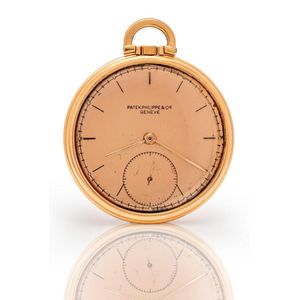
Art-Deco Patek Philippe Gold Pocket Watch, Swiss, circa 1940
An art-deco gold pocket watch, maker Patek Phillipe Swiss circa 1940 4.7 cm diameter, 4.9 cm high. An art-deco gold pocket watch, maker Patek Phillipe. Swiss circa 1940. Very slim, art deco, gold, open-faced dress watch. 18 carat gold case. Metal dial…
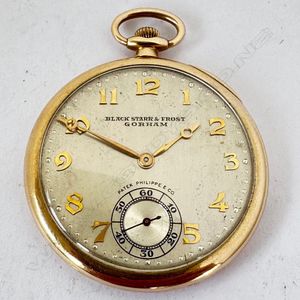
18ct Gold Patek Philippe Pocket Watch by Black Starr & Frost
18ct Gold slim dress style Pocket Watch, with movement by Patek Philippe & Co for Black, Starr & Frost, Gorham. Number 809036. 45 mm slim case marked 18K to back cover and inner dust cover, both with matched numbers to movement, c.1930s. Champagne dial…
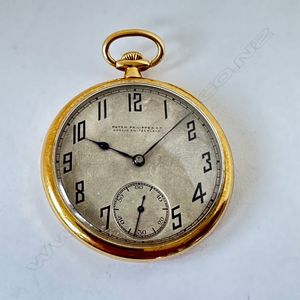
Patek Philippe 18ct Gold Pocket Watch
18ct gold, slim open face cased, dress pocket watch by Patek, Philippe & Co., number 806271, 49 mm plain case, marked Patek Philippe & Co. Switzerland. Matt silver dial with Roman numerals, rail track minutes, subsidiary seconds dial at 6, signed 'Patek,…

Floral Enamel Patek Philippe Pocket Watch, 1850
Patek Philippe open face pocket watch, circa 1850, 18ct gold case, with floral enamel back, enamel dial with Roman numerals, case serial #5486, crystal missing, hands missing. In original tortoiseshell case.
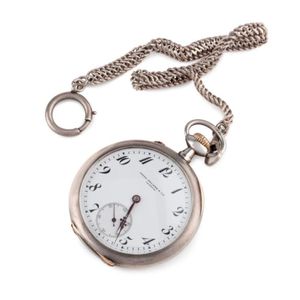
Swiss Patek Philipe Silver Pocketwatch with Enamel Dial
A Patek Philipe silver pocketwatch, Swiss, 1910 white enamel dial with black Arabic Roman numerals, case dial movement signed Patek Phillipe, crown wind, pin set to a 900 silver case 49 mm diameter with 250 mm associated silver chain

Patek Philippe Platinum Pocket Watch
A Patek Philippe open face pocket watch, crown wind, circular white dial with Roman and baton numerals, subsidiary seconds at six, signed case, dial and movement, 18 jewels, three (3) heat, cold isochronism, adjusted to five (5) positions, no 860880,…
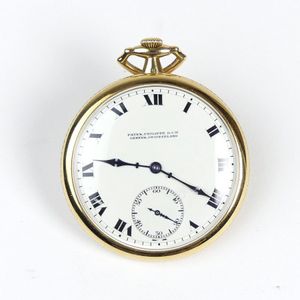
18ct Patek Philippe Pocket Watch with Archive Certificate
An 18ct gold Patek Philippe open face pocket watch, the white enamel dial with Roman numerals and subsidiary second dial, ultra-thin, keyless wind, with Patek Philippe Archive certificate. Total 65.5gm.

1855 Patek Philippe Hunter Pocket Watch with Inscription
Patek Philippe & Co yellow gold hunter pocket watch, circa 1855, case monogrammed and inscribed 'H. S. Houseman From His Mother April 30th 1877', factory inscription on the back (no. 6309), in original fitted box, 4 cm diameter
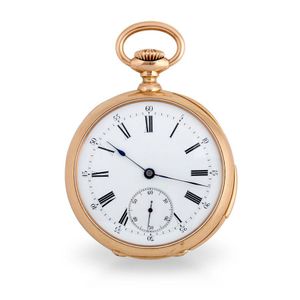
1883 Patek Philippe 18ct Rose Gold Quarter Repeater Watch
Patek Philippe An 18ct rose gold quarter repeating open-faced watch mvt 65665 case 65665 made in 1883, cal. 19' lever movement, fully jewelled, white enamel dial, Roman numerals, outer Arabic and dot minute track, subsidiary seconds dial, blued steel…

1902 Patek Philippe 18ct Rose Gold Open-Faced Watch
Patek Philippe An 18ct rose gold open-faced watch mvt 120883 case 232746 made in 1902, cal 19' lever movement, white enamel dial, red Arabic numerals, outer red minute track, subsidiary seconds dial, gold Louis XVI hands, polished case engraved with…

1895 Patek Philippe Rose Gold Open-Faced Watch
Patek Philippe An 18ct rose gold open-faced watch mvt 105222 case 216908 made in 1895, cal 19' lever movement, fully jewelled, white enamel dial, Roman numerals, outer Arabic minute track, subsidiary seconds dial, gold spade baton hands, engine-turned…

1925 Patek Philippe Gold Open-Faced Pocket Watch
Patek Philippe An 18ct gold openfaced keyless lever watch mvt 803922 circa 1925, nickel lever movement, 18 jewels, gold cuvette, gilt dial, Breguet numerals, subsidiary seconds, polished case engraved with initials WTM, case, dial and movement signed,…

Antique Patek Czapek Gold Pocket Watch, Swiss Cylinder Movement
An antique Patek and Czapek gold pocket watch, key wind and key set Swiss cylinder movement, circular white dial with painted black Roman numerals, cuvette signed Patek Czapek Genewie number 71, 18ct gold case with engraved crest, 45 mm diameter
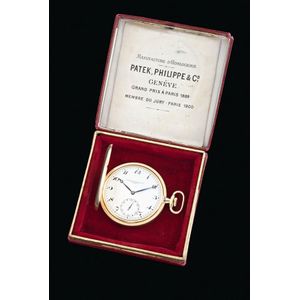
Patek Philippe Gold Hunter Pocket Watch with Original Box
A gold hunter pocket watch, Patek Philippe & Co, dial signed, cuvette signed and numbered 195281, case signed and numbered 289290, movement signed and numbered 195281, 18ct yellow gold, 45 mm, original signed box.
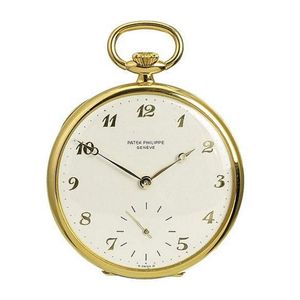
Patek Philippe 18ct Gold Openfaced Watch, 1988
Patek Philippe a fine 18ct gold Openfaced watch Ref 652/1 Mvt 933.279 case 2847248, made in 1988 cal.17-170 manual winding nickel lever movement, lever escapement, 18 jewels, silvered dial, applied Breguet numerals and hands, subsidiary seconds, polished…
 Loading more...
Loading more...